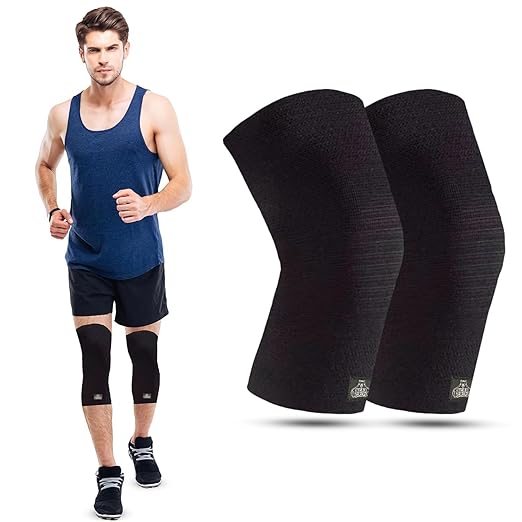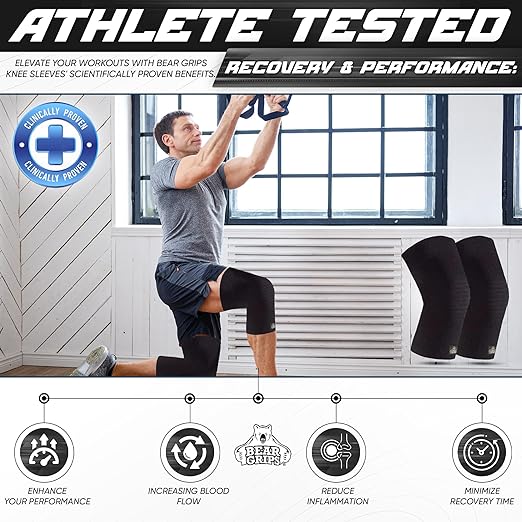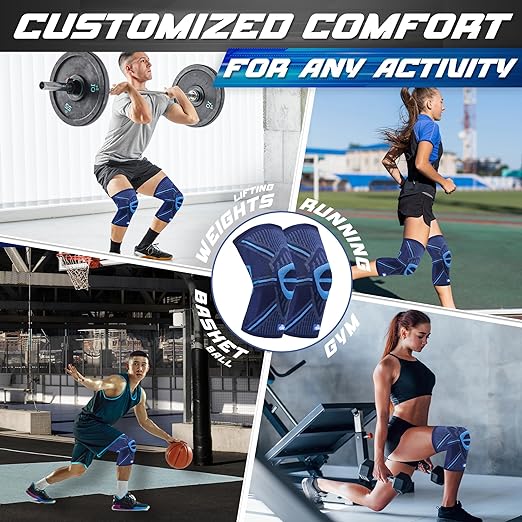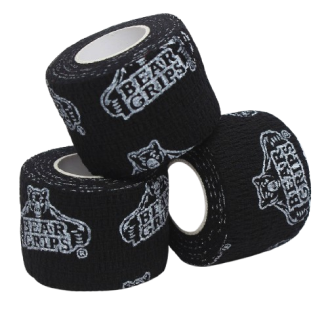
How to Use Knee Wraps?
Share
Knee wraps are a valuable tool for improving knee stability and performance in activities such as powerlifting, bodybuilding, and general fitness. By correctly using knee wraps, athletes can enhance their squatting technique, protect their knees from injury, and increase their overall strength and power. In this article, we will explore the proper techniques for using knee wraps and provide tips for maximizing their effectiveness.
Key Takeaways:
- Knee wraps provide additional support and stability to the knee joint during exercises like squats and leg press.
- Proper wrapping techniques, such as the spiral wrap, can help optimize the effectiveness of knee wraps.
- Knee wraps should only be used when necessary and not relied upon for every exercise or training session.
- Select knee wraps that are the right length, width, and thickness for your needs.
- Incorporating knee wraps strategically into your training routine can help you maximize their benefits and achieve your fitness goals.
Why Use Knee Wraps?
Knee wraps are a valuable tool for athletes looking to enhance their performance and protect their knees during squatting exercises. When used correctly, knee wraps offer several benefits that contribute to their effectiveness and safety.
Enhanced Support and Stability
Knee wraps provide additional support and stability to the knee joint, especially during heavy squatting movements. The wraps help to compress the joint, acting as a supportive layer that stabilizes the knee and prevents excessive movement. This added support can help reduce the risk of injuries, such as sprains or strains, while performing squats.
Improved Performance
Squatting with knee wraps can significantly improve bar speed and overall performance. The wraps act as a spring-like mechanism, storing energy during the eccentric (lowering) phase of the squat and releasing it during the concentric (lifting) phase. This rebound effect allows athletes to lift heavier weights with less effort, maximizing their power and strength potential.
Pain Relief
Knee wraps can also provide relief from knee pain during squatting exercises. The compression provided by the wraps helps to alleviate discomfort by reducing stress on the knee joint and distributing the load more evenly. This can be particularly beneficial for athletes with existing knee conditions or those recovering from knee injuries.
Reduced Risk of Quad Tendon Injuries
A properly applied knee wrap can potentially reduce the risk of quad tendon injuries. The wrap's compression and support around the knee joint help to stabilize the quadriceps tendon, minimizing the strain it experiences during heavy squats. By reducing the risk of quad tendon injuries, athletes can maintain their training consistency and performance levels.
Overall, knee wraps are a valuable accessory for powerlifters, bodybuilders, and fitness enthusiasts who engage in heavy squatting exercises. By providing additional support, improving performance, relieving pain, and reducing the risk of injuries, knee wraps can effectively enhance the squatting experience and support athletes in reaching their fitness goals.

When and How to Wear Knee Wraps
Knee wraps are essential during certain exercises to provide the necessary support and stability for athletes. They are commonly used in exercises such as barbell squats (low and high-bar, front squats, etc.), leg press, and Olympic lifts like clean and jerk and snatch. By wearing knee wraps during these exercises, athletes can protect their knees and improve their performance.
Athletes should wear knee wraps during their main working sets, usually when they are lifting 80% or more of their one-rep max. This ensures that the knees are properly supported during heavy loads, reducing the risk of injury and allowing for better technique and stability. It's important to note that knee wraps should be used strategically and not relied upon for every exercise or training session.
Prior to wearing knee wraps, it is essential to warm up adequately. Dynamic stretching exercises for the lower body, such as lunges or leg swings, can help prepare the muscles and joints for the workout. This warm-up routine helps to improve blood flow, increase flexibility, and reduce the risk of strains or tears.

Once the warm-up is complete, it's time to properly wear the knee wraps. Start by placing the knee wraps just below the kneecap, ensuring they are aligned properly. Begin wrapping the knee with a tight and extended wrap, following the spiral wrapping technique for optimal support and stability. The wraps should be tight enough to provide support but not so tight that they restrict blood flow.
Adjust the tightness of the knee wraps as needed during your workout. Some athletes prefer a tighter wrap for heavy lifts, while others may loosen the wraps for lighter exercises. Experiment with different tightness levels to find what works best for your comfort and performance.
Remember, knee wraps should only be used when necessary to provide additional support. They should not replace proper training and technique. It's important to focus on building strength and stability in the knees through regular exercises and proper form.
Benefits of Wearing Knee Wraps:
- Improved knee stability during heavy lifts
- Reduced risk of knee injuries
- Enhanced performance in powerlifting and Olympic lifts
- Increased confidence and comfort during workouts
Example of a Knee Wrapping Technique:
| Step | Instructions |
|---|---|
| 1 | Start with the knee wraps just below the kneecap. |
| 2 | Wrap the knee tightly in a spiral pattern, maintaining tension as you go. |
| 3 | Continue wrapping until you reach the desired height or until the wraps are secured. |
| 4 | Ensure the wraps are snug but not too tight, allowing for proper blood flow. |
| 5 | Adjust the tightness as needed during your workout. |
How to Wear Knee Wraps Properly
When it comes to wearing knee wraps, there are various techniques you can use. However, the simplest and most effective method is the spiral wrap. Follow these steps to properly wrap your knees:
- Start with the knee wrap tight and extended.
- Place the wrap just below the kneecap.
- Loop the wrap around the knee in an "X" pattern, maintaining tension as you spiral upward.
By using this technique, you ensure that the knee wraps provide optimal support and compression to the knee joint. The ideal tightness of knee wraps is when you can feel some compression around the knee as you descend into a parallel squat.
It's important to find knee wraps that are the right length, width, and thickness for your needs. Look for knee wraps made of elastic material with secure closures to ensure a proper fit and durability.

Benefits of Proper Wrapping Techniques
"Using the spiral wrapping technique helps ensure that knee wraps provide the necessary tightness and compression to support the knees during intense workouts."
By using proper wrapping techniques, you can experience the following benefits:
- Enhanced knee stability
- Increased support during heavy lifts
- Reduced risk of knee injuries
- Improved performance in activities that involve knee movements
Remember, knee wraps should only be used when necessary and not relied upon for every exercise or training session. Use them strategically to maximize their benefits and protect your knees.
Different Knee Wrapping Techniques
Alongside the popular spiral wrapping method, there are other effective techniques for wrapping knee wraps - the triple 'X' method and the bowtie method. Athletes may opt for different wrapping methods based on their personal preferences and the level of support and stability required.
The triple 'X' method involves creating three 'X' patterns, each slightly higher than the previous one, to provide maximum knee stability. This method ensures comprehensive support for the knee joint during intense workouts.
The bowtie method begins at the top of the knee, crosses behind the knee, and ends with a bowtie knot for added support. This wrapping technique offers additional reinforcement and helps athletes maintain consistent knee alignment.
When deciding which method to use, it's crucial to consider individual needs and comfort. Different techniques may suit different body types and activities. Experimenting with different wrapping methods can help athletes find the most suitable approach for optimizing knee stability and performance.
Conclusion
In conclusion, knee wraps are an essential accessory for athletes looking to improve their knee stability and performance in powerlifting, bodybuilding, and various fitness activities. When used correctly, knee wraps can provide numerous benefits, including enhanced squatting technique, increased strength, and reduced risk of injury.
Choosing the right knee wraps is crucial, as they need to fit your needs and offer optimal support. Additionally, mastering the proper wrapping techniques is essential to ensure the wraps provide the desired benefits. It is also important to adjust the tightness of the knee wraps to ensure maximum comfort and support during training sessions.
By strategically incorporating knee wraps into your training routine, you can experience a significant improvement in your performance and achieve your fitness goals more effectively. Whether you are a powerlifter, bodybuilder, or fitness enthusiast, knee wraps can be a valuable tool in maximizing your potential and taking your training to the next level.
Buy the best knee wraps from Bear Grips right now!
Shop Now at Amazon.com.
FAQ
How do knee wraps improve knee stability and performance?
Knee wraps provide additional support and stability to the knee joint during exercises like squats, reducing the risk of injury and enhancing performance.
Who can benefit the most from using knee wraps?
Powerlifters, bodybuilders, and fitness enthusiasts who engage in heavy lifting can benefit the most from using knee wraps.
Which exercises are knee wraps commonly used for?
Knee wraps are commonly used for exercises like barbell squats, leg press, and Olympic lifts such as clean and jerk and snatch.
When should I wear knee wraps?
Knee wraps should be worn during your main working sets, typically when you are lifting 80% or more of your one-rep max.
How do I wrap my knees properly?
The simplest and most effective method is the spiral wrap. Start with the wrap tight and extended, place it just below the kneecap, loop it around the knee in an "X" pattern, and maintain tension as you spiral upward.
Are there different techniques for wrapping knee wraps?
Yes, other techniques include the triple 'X' method, which involves creating three 'X' patterns for maximum stability, and the bowtie method, which creates a bowtie knot at the end for added support.

